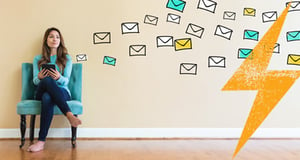
Coronavirus is rapidly changing email marketing as we know it. The good news is that your customers want to hear from brands and this is a great time to build trust with subscribers. The tricky part is ensuring your message gets to your subscribers in the first place, instead of getting caught in spam folders.
To help our clients succeed during this critical time, we’re passing along some wisdom from the ultimate experts—our partners at Hubspot. Here are their words, straight from the inbound marketing software engineers themselves:
COVID-19 Email Sending Tips from HubSpot’s Email Deliverability Success Team
Currently, the level of email sends has reached the numbers HubSpot typically sees on a Black Friday, but the difference is that this was unexpected. Because of this, companies are at an increased risk of damaging their brand’s email reputation with mass bulk emails ‘clogging the pipes’ which can have immediate and long term effects on how your bulk email messages are placed (ending up in SPAM folders) and how your messages are accepted (bounce rate).
HubSpot has put together the following tips and best practices for brands to adhere to during the next few critical months.
Best Practices related to email communication regarding Coronavirus
Who should send Coronavirus related messages?
Any organization whose offered service(s) are impacted by COVID-19. This may include:
- Food Service
- Travel/Tourism
- Theaters, museums and entertainment venues
- Schools and non profit organizations that are closed or need to cancel upcoming events
- Businesses with brick and mortar locations that have closures or amended hours and/or services
Who should not be sending this type of message?
- Businesses that are solely online and whose offerings are not impacted
- Organizations with services/operations not impacted by COVID-19
Here’s why:
- Any send that you do now, regardless of content or messaging, WILL have an impact on your brand sender reputation and deliverability in the future.
- There are impacted industries that do have an urgent need to hit the primary inbox, so as good citizens, we need to make space for truly mission critical emails.
If you DO need to send a mission critical message, DO NOT SEND TO YOUR ENTIRE LIST.
- Blasting to your entire database greatly increases your risk for future deliverability for the next few months…and even longer. Segment your lists to only those that have engaged with at least one of your emails in the past 6 months.
- Consider other channels to communicate how your company has been impacted and how you can help:
-
- Website messaging (banner message)
- Social channels
Tips for email marketing campaigns
All of the caveats described above exist for large sends of any type. Understanding that a company may still want to keep communications flowing using email as a tool, here are some best practice tips:
- Send only to the segment of your database that:
-
- Has explicitly given consent to receive marketing information
- Has interacted with at least one email within the last 6 months
- Fits as a recipient to your messaging (i.e., sending service hour changes to customers only)
- Flex your empathy muscles
-
- --in the way that you send emails and the messaging you use
- --in the way that you choose NOT to send emails. Be a ‘selfless’ sender.
- Remember that your behavior at this moment not only effects your sender reputation, but it also effects the way your contacts perceive you moving forward.
Hear more of our perspective on advertising in the age of COVID-19, in our interview with AdChat DFW.

